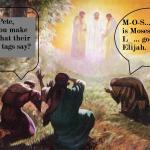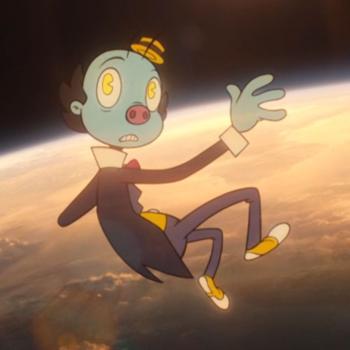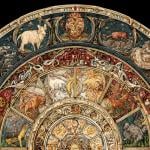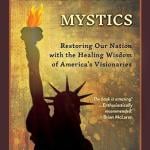This post about the 2024 Doctor Who Christmas special “Joy to the World” will contain spoilers, because this is an episode that a religious studies professor who writes about Doctor Who has to comment on, and there’s no way to do so without discussing details, including the ending.
The episode “Joy to the World” doesn’t just have the vague holiday connection that Christmas episodes tend to. The Doctor finds himself at the Time Hotel, which allows people to visit Christmas in just about any time period. The Doctor quips early in the episode (and mentions again later) that this explains why there was “no room at the inn.”
That isn’t the main storyline as far as one can tell, and yet it will nonetheless turn out to be. The main focus is a briefcase by the arms manufacturer Villengard, which contains a star in the making. It will require billions of years to develop and so they realized they can use the Time Hotel. Just get the briefcase to billions of years in the past and then pick it up when the star is ready. Presto, a ready-made source of power. It turns out that this isn’t a weapon intended to destroy earth, but Villengard certainly is perfectly happy to have numerous sentient beings’ lives end in the process of accomplishing their mission.
The briefcase gets eaten by a dinosaur and then billions of years later has ended up in a shrine, suggesting that it became the object of religious devotion. The Doctor comments that the briefcase possesses people, and “that’s basically how you start a religion.” In the end, the character Joy ends up united with the star seed, so that literally “the star seed will bloom and the flesh will rise.” She ascends into the air where the power source that she is now a part of can be collected by Villengard. For a moment, however, it shines at Christmas time in different eras, including
Let me point out the obvious plot hole. The star needs to appear to guide the magi to Bethlehem. That was the point. Yet in what we watch in “Joy to the World,” the star just then went up into the sky, and moments later there are three camels parked at Bethlehem. There’s more to be said about timing, since not only this episode but the source material in the Gospels has issues.
Just as a reminder, this was not the first visit of the Doctor to Bethlehem. Indeed, there may be multiple Doctors visiting this moment, if this episode provides a clue. The Doctor says in “Voyage of the Damned” that he was there for the first Christmas and “got the last room.”
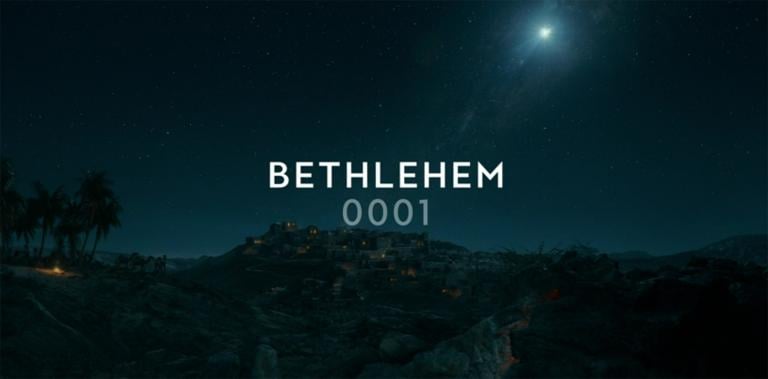 A scholar of early Christianity is going to have to nitpick in other ways as well. At least they didn’t make it the year 0. But let’s talk about the date of the story depicted in the Gospel of Matthew and featured in this episode, with a star and Bethlehem. Matthew places the event when Jesus is roughly two years old (since the star appears to herald his birth and after the magi explain when they saw the star appear, Herod proceeds to order the slaughter of all male infants two years and under. The fact that Herod the Great has not died means that Jesus’ birth must take place in or before 6 BC based on the details Matthew provides, with the story happening in 4 BC at the latest. Luke’s Gospel has completely different geographical movements and connects Jesus’ birth with the census under Quirinius which happened in 6 AD after the transfer of Judaea to direct Roman rule. This happens after Herod’s son Archelaus is deposed, which happened in turn after Herod the Great died and his kingdom was divided into tetrarchies ruled by his children. It is not just a difference of date. There is no way for Jesus to have been born at least 2 years before Herod the Great died and yet also after his son Archelaus is no longer ruling. Note as well that Matthew 2:21-23 explicitly says that Archelaus is ruling Judaea when Matthew makes the family, originally from Bethlehem, settle instead in Nazareth for the first time. With such contradictory and problematic source material, I’m not going to hold it against Doctor Who that they didn’t get the date “right.” There is no right date if one takes seriously the contradictions between the Gospels of Matthew and Luke.
A scholar of early Christianity is going to have to nitpick in other ways as well. At least they didn’t make it the year 0. But let’s talk about the date of the story depicted in the Gospel of Matthew and featured in this episode, with a star and Bethlehem. Matthew places the event when Jesus is roughly two years old (since the star appears to herald his birth and after the magi explain when they saw the star appear, Herod proceeds to order the slaughter of all male infants two years and under. The fact that Herod the Great has not died means that Jesus’ birth must take place in or before 6 BC based on the details Matthew provides, with the story happening in 4 BC at the latest. Luke’s Gospel has completely different geographical movements and connects Jesus’ birth with the census under Quirinius which happened in 6 AD after the transfer of Judaea to direct Roman rule. This happens after Herod’s son Archelaus is deposed, which happened in turn after Herod the Great died and his kingdom was divided into tetrarchies ruled by his children. It is not just a difference of date. There is no way for Jesus to have been born at least 2 years before Herod the Great died and yet also after his son Archelaus is no longer ruling. Note as well that Matthew 2:21-23 explicitly says that Archelaus is ruling Judaea when Matthew makes the family, originally from Bethlehem, settle instead in Nazareth for the first time. With such contradictory and problematic source material, I’m not going to hold it against Doctor Who that they didn’t get the date “right.” There is no right date if one takes seriously the contradictions between the Gospels of Matthew and Luke.
Hopefully this interesting exploration of religion won’t distract from a more subtle and religiously interesting plot thread. Because of how events unfold, the Doctor has to spend a year waiting for the next chance to access the Time Hotel. As a result, he spends a year in the hotel on Earth where he first meets the character Joy. There he makes a connection and becomes friends with the manager of the Sandringham Hotel whose name is Anita. They hang out once a night, as a result of a deliberate effort by the Doctor, after he notices that his TARDIS has no chairs because he never expects guests to stop by. The whole story is more about human connection and the time and deliberate choice it takes to foster that. Such things are what make life meaningful. When we can’t be there for those we love, it may leave us with a feigned smile and bubbling rage beneath the surface. “You need to find a friend.”
There were many great lines, including “Evil must logo,” a hotel room is you without the makeup, the code (to the briefcase) came from nowhere but so did the universe and no one seems to mind about that, and the mansplaining by the briefcase (and the Doctor as mansplaining central).
Related to this topic, see my previous posts about time travel and Christianity, and also read my short story “Certainty” for my own fictional take on time travel to the first century. See as well Garry Kilworthy’s classic story “Let’s Go to Golgotha.” It envisages time travel tourism akin to what is featured in this Doctor Who episode.
As so often, this is an episode that is not free of logical issues (time travel stories never are) but that has emotional depth and seriousness that makes it a rewarding watch.
What did you think of “Joy to the World”?
The Past, Present, and Future of Christianity in Science Fiction Part One: Past
The Gospels Meet Science Fiction: Time Travel, Historical Fiction, and Alternative History


